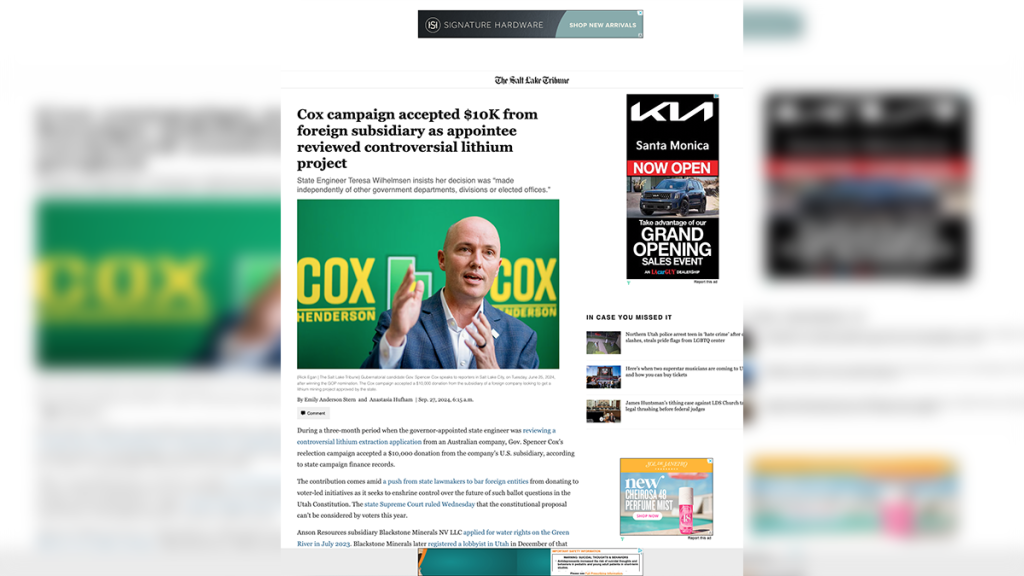
Current ad display on one of our article pages of The Salt Lake Tribune
The importance of ads on article pages: Balancing revenue and reader experience
How strategic ad placements on news websites can support quality journalism without compromising user engagement
In today’s fast-paced digital landscape, the need for quality journalism has never been more important. News organizations are faced with the challenge of producing reliable, well-researched content while also maintaining financial sustainability. For many news websites, advertising remains a critical component of funding.
Why ads are necessary
Running a news website involves significant costs. Journalists need to be compensated for their work, websites must be maintained and updated regularly, and there are various other operational costs. In our case, at The Salt Lake Tribune being a non-profit, allocating proper funding is critical. While some news outlets rely on subscriptions or donations, ads continue to be one of the most accessible and immediate ways to generate revenue. This allows the content to remain accessible to a wider audience.
Ads on article pages: A balancing act
The placement of ads on article pages is especially important, as these are often the most-visited sections of any news website. However, it’s essential to strike a balance between user experience and revenue generation. Too many ads or disruptive ad formats can lead to a negative user experience, causing readers to leave the page or block ads entirely.
Best practices for ads on article pages
- Strategic Placement: Ads should be placed in locations that do not disrupt the flow of reading. Common placements include above the fold, in the sidebar, or within the article body, but only after a few paragraphs. For us at The Salt Lake Tribune, we place an ad every 5 paragraphs in our article pages.
- Non-intrusive Formats: Formats such as banner ads or native ads (ads that blend in with the article’s content) tend to perform better because they are less disruptive. Pop-up ads, on the other hand, can lead to frustration and may drive users away.
- Optimizing for Mobile: Since a significant portion of readers access news through mobile devices, ensuring that ads are responsive and mobile-friendly is key. Large, unoptimized ads can negatively impact mobile user experience and slow down page load times.
- Content and Ad Relevance: Ads that are contextually relevant to the content can improve user engagement. For instance, if an article covers local events, placing ads related to local businesses or services might resonate better with readers.
Testing CPM and impressions: The impact of house ads
In July and August, we conducted a series of tests to measure the effectiveness of ads on our article pages, focusing on CPM (cost per thousand impressions), overall impressions and CTR (click thru rate).
In August, with help from our Digital Marketing Coordinator Katie Clark, I specifically used house ads—advertisements promoting our own content or services, in this case our subscriber survey ad, instead of third-party ads.

This gave me more control over ad content and allowed for better targeting. Interestingly, while the number of impressions remained stable, the click-through rate (CTR) saw a noticeable dip during the house ad test. This suggests that although house ads can maintain visibility, they don’t engage readers as effectively as third-party ads. This data will be key in determining how we balance external ads with our own promotional content in the future.
Exploring new placement strategies: Donation asks
As we continue refining our ad strategy, placement plays a critical role in user engagement and revenue. Our next test will focus on swapping out one of the in-article ads for a donation ask.
By positioning the donation prompt in a high-visibility area within the article body—where ads typically perform well, we hope to test whether readers are more inclined to contribute financially to support our journalism rather than clicking on an ad.
This experiment will help us understand how donation requests compare to traditional ads in terms of user engagement and potential revenue, allowing us to explore more sustainable options for funding our content and also offering a better user experience.
Navigating the future of revenue and engagement
Our recent ad tests, ranging from CPM and impressions analysis to experimenting with house ads and donation asks, have given us valuable insights into how readers interact with ads on our article pages. These findings highlight the ongoing challenge of balancing revenue generation with maintaining a seamless, enjoyable reader experience.
As we move forward, we recognize the importance of reconfiguring our ad taxonomy in order to generate reports to show CPM, Viewability, Sell Through, etc by ad slot for an entire site or all the way down to subsection.
This restructured taxonomy can also provide better reporting by property (website, e-edition, and other sites owned by The Salt Lake Tribune) and by inventory type (video, display, app), says David Fleischman. This is something we plan to incorporate in the near future, allowing us to refine our approach even further.
However, this will be a heavy technical lift and is easier done when first creating your news website. With help from our partner David Fleischman at Opsco, this propagation will be possible to achieve. Stay tuned for the results of our ad tests in the final resource project.
Cite this article
Partida, Alex (2024, Oct. 2). The importance of Ads on article pages: Balancing revenue and reader experience. Reynolds Journalism Institute. Retrieved from: https://rjionline.org/news/how-to-onboard-a-freelance-photojournalist/
